Richard Ashworth: The Cattleman Who Barely Left a Trace
By Alexandra Deselms, Interim Director & Director of Collections
Meeteetseans know the story of Richard Ashworth, his unique house, and the jealousy of his foreman, Wilfred Jevons. But do you know the full story?
Richard Ashworth was born between 1853 and 1856 in England (sources vary). One of his brothers, Oliver, was born in 1855 or 1856 and was likely a year younger than Richard.
The 1861 English census lists Richard (age 6) living with his parents (Edward and Helen), sister Alice, and brothers Oliver (age 5) and Edward Jr in the civil parish of Spotland, Lancashire. They had three boarders or servants living with them, and Edward (age 30) is a merchant. According to The Brand of a Legend and other articles written in the 1970s, the Ashworth family was in steel (and this was how they could afford to send Richard to the “farthest reaches imaginable”). It is possible that the family were steel merchants but did not identify the type of merchant they were in the census itself, as the Jevons family would later in the census. Richard, Oliver, and Alice’s birthplaces are listed as Whalley (or possibly Halley), Lancaster. Edward and Edward Jr were born in Spotland while their mother was born in Halifax/Haliface, Yorkshire.
In the 1871 English census, Richard (age 15 or 17) and Oliver (age 16) are listed at boarding school attending the Hampstead, St. John School in London. Both boys’ birthplaces are listed as Manchester, one of the two largest cities then in the county of Lancashire.
The 1881 English census presents an interesting puzzle. Richard’s mother Helen (age 49) is shown living in Newchurch, Lancashire with her sons Edward Jr (21), Oliver (merchant, 26), and Oliver’s wife Annie (26) as well as seven servants, showing the family as “well to do.” The servants’ jobs are listed as cook, housemaid, nurse, laundress, ladies maid, parlor maid, and kitchen maid. However, there is no mention of either Richard or his father Edward. Since later that year Richard arrived in the United States, perhaps Richard (and his father?) were already on their way to the U.S. when the census was taken. (Showing the unfortunate lack of consistency found sometimes in census records, Edward and Oliver’s birthplaces are now listed as Newchurch, Lancashire while mother Helen’s is Heptonstall, Yorkshire and her daughter-in-law Annie was born in Bahia, South America.)
Richard arrived in either June from Liverpool aboard the ship England at the age of 29 or April at age 26 with a brother listed as Walter (18) aboard the ship Gallia. While there are several Walter Ashworths living in Manchester in 1895 at the same time as Edward, Oliver, and Edward Jr, no record of a Walter Ashworth in this family have been identified in census records so we are inclined to credit the June date, even if the age might be closer on the April trip. According to the book Wyoming’s Big Horn Basin to 1901, Captain Henry Belknap (an “Englishman” who was actually born in Massachusetts in 1826, traveled in Europe and Asia, and fought in the Civil War in the U.S. infantry) convinced his good friend Richard to come out west to the Bighorn Basin.
A 1947 Annals of Wyoming journal article (quoted in Freund & Brothers: Pioneer Gunmakers to the West) and the transcribed memories of Frances Belden both refer to Richard as a “remittance man”. A number of “remittance men” ended up in the American West in the nineteenth century. Remittance men were usually the “black sheep” of wealthy or noble English families, whose exploits caused the men to be sent West after all other hopes had failed and whose wealth enabled the families to keep them comfortable in their new homes. “Remittances” or allowances were sent regularly (often monthly) to the men, who often paid their landlord and then eagerly spent all their money. We are not sure if Richard truly was a remittance man, but his money troubles (his father was required to heavily reinvest in the ranch and loan money to him) may point to this being true.
A true remittance man or not, Richard was in the Bighorn Basin in late 1881 and started the Z-T ranch along the Greybull River in 1882 with his partner James C. Johnston. His address is listed as the Cheyenne Club (more information here), and Richard and his partner’s brand is the double milliron brand. Within the next year, they had also started the Hoodoo Ranch along the Greybull and Upper Sage Creek.
Apparently, not long after Richard had arrived and took a ranch in Powder river, two men (Charles Boyer or Bowyer and Charles Policy or Palliser) stole horses and other items from Richard in September 1881. The stolen items included “a black work horse, one black pony, one cream colored pony, a Sharpe’s rifle (Freund’s make), a Winchester rifle, a colt’s fourteen inch six shooter, with scabbard and belt, two blankets and a game pouch, two saddles and an opera glass.” It is not known whether the items were recovered, but (as discussed later), Richard had a collector’s habit. Indeed, “Ashworth, who was a bachelor when he came West, brought with him from England some of the trappings of the British aristocracy, as when he imported a pair of Scottish fox hounds.”
There is a record showing that Richard filed an abstract of the Declaration of Intention to begin the process of naturalizing as a citizen in Laramie county in 1882. This appears to be all the farther he went in the process as no other naturalization record has surfaced in our research.
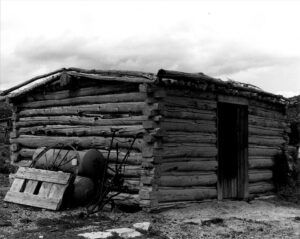
Bunkhouse at the Quien Sabe Ranch in 1989 from the NRHP Listing, found here.
At some point in 1883, Richard started another ranch, this time in (current) Fremont County with Harry Jevons and Richard Berry. They called their ranch the Quien Sabe Ranch and it survives to this day, although ownership has passed out of the original owners’ lines.
A count by Charles Wilson from Northern Pacific out of St Paul during the summer of 1883 listed the herd of Richard and James Johnston at 2000 head. Richard was voted in as a member of the Wyoming Stockgrowers Association in April 1883.
It was announced in the paper in October 1883 that Richard, his partner James, and Cecil H Aleyne (a cattleman from Stinking Water) were in Billings and leaving for home, stating that all are “active, intelligent gentlemen.” Richard seems to have been very popular among his new neighbors and in the cities of Montana and Wyoming and regarded as congenial. There are several such complimentary remarks in the newspapers.
While Frances Phelps Belden never met Richard and may not have met Richard’s neighbor Otto Franc, she describes them very differently in her transcribed memories in Brand of a Legend: “Franc, from all that I have ever heard, was a totally different type from Ashworth. He was an aggressive, acquisitive man, believing that with the Pitchfork as the center of his operation, that he was the lord and master of the lands stretching in every direction, far further than he could see.” Frances also said that, “Richard Ashworth was a very colorful character, from all accounts, though I have never seen a picture or heard a description of him. I have no idea of his age.”
In either 1882 or 1883, Richard had the fiddler George Marquette begin constructing the buildings on the Z-bar-T ranch, in particular, his unique house. Some of the cowhands apparently thought the buildings impressive enough to call them “Ashfordvill”. “The house in which Ashworth had lived was a long low rambling log house which we were told had originally been a stable, but the living room, some 30×20 feet, had a large stone fireplace on the side opposite the front door and windows.” Frances Belden continued on to describe the house in her typed memoirs in Brand of a Legend:
“There was so much about that old house that was characteristic of its original owner. Practically every room had a trap door in the floor with a cellar below, all built to fit a case of whiskey so that he could never be caught unprepared. The root cellar, under ground, connected with the kitchen by a short roofed passage, had a chute going down from ground level to facilitate the unloading of case goods, but again, first the size of a case of whiskey, as were the pack panniers for the mountain trips.”
Frances mentioned that she and her brother Eugene played in these underground cellars. She said that the “House was really just a series of log houses hitched onto one another with connecting passageways, leaving small open spaces between, which mother made into gardens and the whole connected back and front with covered porches.”
The Phelps family later filled the house with their own collections of paintings and Indian artifacts. But even with Richard Ashworth, “it was filled with many interesting relics of earlier times, even in those days. There was a gun rack which held a dozen or more old carbines and flintlocks. On the walls were framed, lovely old English hunting scenes, and early English steel engraving treasures of Ashworth’s.” Unfortunately, most of these items were lost when the house burned on a cold December day in 1918, with wind speeds of up to 75 miles per hour.
Richard welcomed guests to his new house, and in March 1884, Victor Arland stayed at the ranch, even writing a letter to his best friend on ranch stationary. In April, Richard dug or improved Ashworth Ditch No 1 on Four Bear Creek (for more on Four Bear Creek, see this presentation on Col. William Pickett (The Life of Colonel William D. Pickett – YouTube). The newspapers reported him being in Billings that May. In August, Richard turned his attention to digging or improving another ditch, this one Ashworth No 2 on Rock Creek.
He reportedly traveled back to England every winter, but he also stopped at other places. For example, a mention published in the Cheyenne Daily Sun on November 2, 1884 announced Richard’s return from St. Louis, Missouri.
In March of 1885, Richard dissolved his partnership with James Johnston; Richard agreed to carry on the business and pay any liabilities.
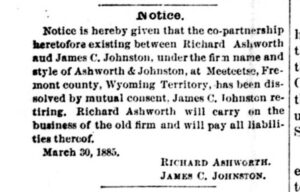
Billings Herald published April 18, 1885 on page 3.
In April, Otto Franc was in Billings on the way back from Chicago to pick up bulls for himself, Richard, Henry Belknap, and M.E. Carter to breed up their stock. In May, the consignment of bulls for the men arrived at Huntley, Montana.
In 1885 or 1886, Richard signed the petition to build a bridge on the Greybull River with a number of other citizens of the area, including Henry Rivers of Rivers Saloon, Daniel Weller (of the later Weller Hotel, and Robert Parker (Butch Cassidy). The bridge was constructed in 1886, and led to the development of the current Meeteetse townsite.
Richard often went back to England for the winters, and in April 1886, he reported to the newspapers that the English winter was unusually severe, with more snow and ice than for many years. However, it was still nice for him to spend some time in London.
In July and August 1886, the notice appeared in the newspapers that Richard had proved his land claim through cultivation. The witnesses included his former partner James C Johnston. Later in September, he served as a judge for thoroughbreds and premium herds at the state fair.

(Left) North Western Livestock Journal, January 21, 1887, page 7. (Right) North Western Livestock Journal, January 21, 1887, page 8.
In January 1887, Richard’s name appears as a reference for a cattle breeder and dealer, and he is also noted in a list of brands (he has two). These reference and brand lists are repeated in June and February.
In May, Richard got two Thoroughbreds from Otto Franc. In September, the North Western Livestock Journal reprinted a mention in the Billings Gazette that “Richard Ashworth is outfitting today a good sized pack outfit with which he will, accompanied by several men, make an extended trip through the National Park.” Richard continued to be active and in October, Richard challenged a man to a footrace but lost in front of a reported 250 spectators; Richard had sprinted while the other, a Dr. Stevens, jogged at a consistent pace and eventually passed Richard when the Englishman slowed down. In November, Richard (and his men) finished moving cattle for the season from the Greybull area to new ranges on the Crow Rosebud agency in Montana. There was also talk in the newspapers of a large purchase of range stock (in the Rosebud) next year. In addition, he participated in a “Kinder-simphonie” concert at Library Hall in Cheyenne (a toy or children’s symphony with shorter sections and places for toy instruments and bird calls to be included).
It is about this time that Wilfred Jevons comes into our story. The story about Richard and Wilfred Jevons is thought to be the basis for a romance novel based in Wyoming called “The Phantom Lady” by Emerson Hough. It features a love triangle between the two men and a young woman working on the ranch. It is said that Wilfred shot at Richard over the young woman and then shot himself, thinking he had killed his one-time friend. Our research shows that while it may be a nice story, it is not historically accurate.
Wilfred Jevons was born in the spring of 1858 (or possibly 1857), only a year or two after Richard (so not the age discrepancy the legend says). When Wilfred was three, the 1861 English census showed the Jevons family in Toxteth Park, Lancashire. In the 1871 census, Wilfred was a pupil at the age of 13 at St. Thomas, Lancaster.
Wilfred arrived in the United States in July of 1880, possibly as a student, aboard the ship Algeria that sailed from Liverpool, England and Queenstown, Ireland. His age is listed as 23.
However, Wilfred is also listed with his family in the 1881 English census in Toxteth Park, Lancashire. He is 23, unemployed, and his father Henry JP is listed as an iron merchant. So perhaps Wilfred returned later that year after what we might today call a “study abroad” trip.
In 1883, Wilfred also filed an abstract of the Declaration of Intention in Laramie County. This is only one year after Richard filed his own Declaration.
In March of 1889, Richard (approximately age 32) and Wilfred (approximately age 31) arrived in New York as saloon passengers (likely first class passengers) aboard the Celtic, which sailed from Liverpool, England and Queensland, Ireland. Their occupations are hard to read but appear to read “cattleman” or “Landmen”. The two continue to be linked together over the next few years, but not in the way the story has been told.
1899 Celtic Passenger List, Ancestry.com
1890 is the year of Wyoming Statehood and proves to be busy for Richard. In January, one of his land patents was issued for 616 acres where Rose Creek meets the Greybull River. In March, the Crow tribe on the Rosebud Agency revoked stock permits from most ranchers (especially for sheep men); Richard is one of the few allowed to continue to graze on the reservation. In May, Wilfred sold his ranch, Prairie Cattle Company, to Richard. In September, he shipped a large train load of cattle from Red Lodge to Chicago.
In March 1891, another land patent was issued to Richard for 160 acres on Hoodoo Creek. In August, he and the Murphy Cattle Company shipped 23 cars of cattle to Chicago to Red Lodge; they planned to ship again the next month. A Wyoming paper reported in April that “The Murphy Cattle Company of Buffalo has purchased the entire herd of cattle belonging to Richard Ashworth, ranging on the crow [sic] reservation. The herd numbers 5000 head of stock.” In September, Richard was back in Chicago due to the high interest and good prices for cattle. In December, the Helena paper announced that the “cattle dealer” Richard Ashworth was in town on December 20th and that Richard was one of the “cattle kings” returning from Chicago on the 27th.

Helena Independent, February 21, 1892, page 2.
In February 1892, Richard announced in the Helena paper his plan to give a sleighing party; however, we’re not sure if it actually occurred. In March, he read the paper “Nature” at the Eclectic Club; the piece was a strong protest against the attempt to “despoil” Yellowstone National Park. In May, three men were captured and accused of changing cattle brands, including Richard’s; the criminals arrived in Red Lodge in June.
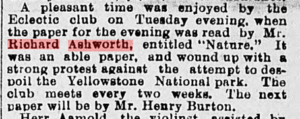
Helena Independent, March 20, 1892, page 1.
Richard returned to England and arrived in either June or July. There are two passenger lists with his name on them. If he arrived in Liverpool in June, he was aboard the Lake Huron sailing from Montreal. If he arrived in Liverpool in July, he sailed from New York aboard the Alaska.
In October 1892, he shipped fifteen to twenty cars of beef cattle from Red Lodge to Chicago.
In April 1893, the “big stock man” Richard Ashworth was in Red Lodge, purchased a “fine span of horses,” and headed to Billings by wagon. In May, the superintendent of the Carry Cattle Company in Arland rented the YU Ranch on the Greybull to Richard, who had purchased 800 tons of hay that was on the ranch.
Also in May, Richard’s brother Oliver arrived in New York from Liverpool aboard the Germanic. His age was listed as age 38 (born 1855) and was a “Merchant,” with his last residence in London. He traveled in the state rooms with 7 bags and was listed as a “transient.”
In June and July 1893, Richard applied for Timber culture permits and the notice was in the newspapers. In July, John Corbett of Arland was in Billings getting supplies for Richard.
In October, Paul Breteche (a Frenchman in the Bighorn Basin) sold 1500 cattle to Richard; Paul and his wife also visited Richard during this time. In November, Richard shipped six cars of cattle from Red Lodge and was erecting extensive sheds and corrals for his cattle. In December, he was getting the cattle rounded up and driven to the home ranch to feed during the winter while 300 of the Breteche cattle were delivered.
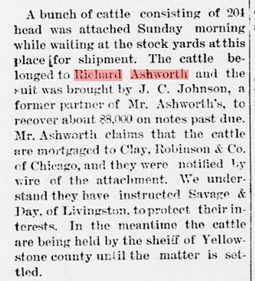
Red Lodge Picket, January 13, 1894, page 3.
In January 1894, 204 cattle were held by the Sheriff during a lawsuit from James Johnston against Richard. Unfortunately, we don’t know the outcome of this lawsuit or what happened to the cattle. In March, the papers reported that “Ashworth of Arland” was visiting relatives in England. The same month, Wilfred Jevons married Marie Grace Winifred McKeown of Billings in Arland with a license (from Fremont County); Grace was 17. Subsequently, Wilfred bought Richard’s interest in the Picture Frame ranch.
In May, the papers reported that a lot in Cheyenne owned by Richard was for sale because the real estate and taxes were due (actually past due for a total of $33.10, which today is $1125). Here we have the beginning of Richard’s money issues.
In November, another land patent was issued for 160 acres near the location of his 1890 patent.
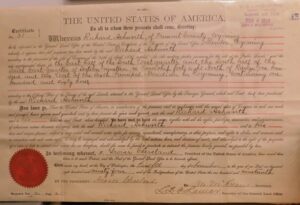
Meeteetse Museums Collections 2019.0016.0001 Copy of 1894 Land Patent
At some point during the 1894 year, Richard sold the small ranch back to Wilfred Jevons, who then deeded the land to Edward Ashworth of England (Richard’s father) to guarantee a loan of $5757.62 at 10% interest with Clay & Forrester of Chicago. According to a handwritten list in the museum’s reference files about tax records from a commissioner’s meeting, Richard also transferred property to his father in 1894. Meanwhile, in 1894-1895, Richard’s brother’s Edward Junior and Oliver were on the Southeast Lancashire Electoral Register. In 1895, Oliver and Edward (and possibly Richard and Walter) were listed in a Manchester city directory.
In January 1895, Richard and Wilfred paid a call on Otto Franc that Otto recorded in his diary; this entry is elaborated on in Brand of a Legend which described Wilfred as a remittance man and mentioned he may have previously known Richard.

Cheyenne Daily Leader March 10, 1895 notice of Wilfred Jevons’ burial.
On February 17, 1895, Wilfred Jevons committed suicide in Arland. The obituaries published in March discount the legend that Wilfred was jealous of a mutual lady friend and shot at Richard then rode away and shot himself. Instead, the obituaries describe a man who lost all (or nearly all) of his money gambling with the dentist Dr. Johnson in Arland and subsequently shot himself. The memoirs of Meeteetse rancher Tom Osborne colorfully claims that Wilfred (from a ranch near Lander “Kin Savey” (likely Quien Sabe)) “gambled all of his money away and after taking two nights to do so, was in such a frame of mind that he blew all of his brains out. He pointed his own gun to his head and splattered the wall of the place.” He had recently taken out a $10,000 life insurance policy, which went to his widow; the papers described Wilfred’s family as “highly connected” in Manchester. He is buried on the hilltop cemetery at the Pitchfork Ranch (this part was originally part of Richard’s Z-T).
In May, the notice of Richard’s delinquent taxes on the Crow reservation was published in the papers. The amount owed? $4201.15. (Today, $146,188.02.) In November 1895, Red Lodge notified Richard that if he would pay the taxes on his cattle, they would let the balance go and have the county straighten up the situation.
All of these notices of tax delinquency and other cash problems culminated in a Helena lawyer taking possession of the ranch on behalf of Richard’s father in 1896. Richard was to operate the ranch under the lawyer’s supervision… Unfortunately, this didn’t solve the problem.
In January 1896, Richard was in Red Lodge on the way to his Arland ranch; the paper reported he would return shortly and make the trip to England. The next mention of Richard isn’t until November. The papers announced that Richard (this time listed as “of Wise, Wyoming”) was going to England for a visit with relatives during the winter. We find a record of him sailing from New York to Liverpool as a “Gent” (gentleman) aboard the SS Teutonic, which arrived December 9th. He is listed as age 35, born 1861.
While Richard was away, a notice was printed in the papers that he was again on the delinquent tax list for Carbon County Montana (Red Lodge). This time the total was $8.62 (today, just shy of $300). In January 1897, the notice was republished.
In April 1897, Richard returned to his Greybull ranch from his visit to England. In May, he went up to Red Lodge and the paper reported that he had seen very dry weather in his section of the country.
We hear nothing about Richard from then until the summer of 1898, where it was reported that his brother Oliver was staying with him for the summer. At the end of summer, in August, Richard was on his way to Billings from his ranch when he stopped in Red Lodge to report that five people had died crossing the ferry at Thermopolis, but that that was all he knew about the matter.
Things Come to a Head

Billings Gazette, April 11, 1899, page 3.
1899 is when things get interesting. In March, Richard was reported to be seriously ill in Portland (Oregon). In April, it was reported he spent part of the winter in Honolulu; the last the paper heard of him (in April), he was sailing for Japan and had “been in poor health for some time.”
(Meanwhile, Wilfred Jevons’ heirs were granted land patents under the Desert Lands Act; the notice was in the papers in March and Richard was one of the witnesses. In May, Wilfred’s widow Grace remarried in Billings to Howard F. Welsh; she had lived with her sister in Butte after receiving the life insurance money and had also attended a music college in Canada.)
In early to mid-May, the Daily Intermountain and Red Lodge Picket reported that Richard the “millionaire cattleman of Wyoming” (debatable since he was in financial trouble) was in Yokohama, Japan, where he was traveling with an unnamed English lord and wrote that he may do the Occident for several months.

Daily Intermountain, May 13, 1899, page 13.
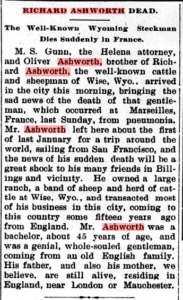
Billings Gazette, May 30, 1899, 3.
Richard Ashworth died in late May in the Mediterranean on a steamer near Marseilles, France. He was traveling on his pleasure trip and the paper reported his death due to pneumonia. On May 30, his death was announced in the Montana papers. It was reported that he had left January 1st for a world trip from San Francisco (which was difficult since he was reportedly recovering in March in Portland, unless he only traveled a little before going to Portland). In the announcement, it was also reported that Richard’s brother Oliver and the attorney MS Gunn had arrived in Billings (indeed, they brought the news of Richard’s death). The Gazette described Richard as “a bachelor, about 45 years of age, and was a genial, whole-souled gentleman, coming from an old English family. His father, and also his mother, we believe, are still alive, residing in England, near London or Manchester.” Frances Belden’s memoirs said that he died from delirium tremens; while either delirium tremens or pneumonia could be correct, the description of his whiskey hide-e-holes certainly gave rise to the belief that he was likely an alcoholic and withdrawal could have been the cause (perhaps even leading to pneumonia when his immune system was impaired).
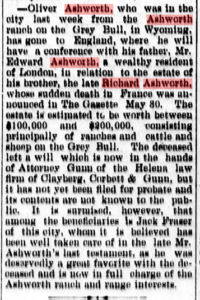
Billings Gazette, July 18, 1899, 3.
Also in July, the papers reported that Richard’s brother Oliver Ashworth was in Billings and “has gone to England, where he will have a conference with his father, Mr. Edward Ashworth, a wealthy resident of London….The estate is estimated to be worth between $100,000 and $200,000, consisting principally of ranches and cattle and sheep on the Grey Bull.” (Today, that estimate would be between $3,521,638.55 and $7,043,277.11.)

Billings Gazette, July 25, 1899, page 3.
The same month, it was announced in the Billings Gazette that Mrs. H.F. Welsh (formerly Mrs. Wilfred Jevons) was named as a beneficiary is Richard’s will. The will was made public in August.
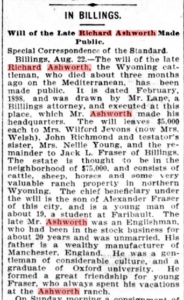
Anaconda Standard, August 24, 1899, page 9.
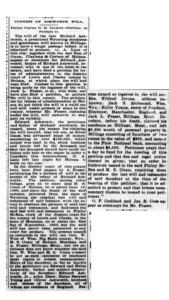
Billings Gazette, September 22, 1899, page 5.
In September, the Montana papers reported a dispute over who was the estate executor or administrator, with the case to be heard in October. The location of which county to file the probate and will in was also under contention (Billings and Helena both had claim with Richard having business and a bank account in each). A copy of the petition for probate was also reported in the papers.
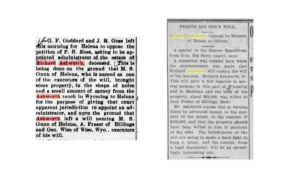
(left) Billings Gazette, September 22, 1899. (right) Wyoming Tribune, October 8, 1899.
In October, the newspapers announced that Richard’s father, Edward Ashworth, was contesting the will. The case began that same month. The Billings Gazette reprinted the Meeteetse News article that Judge Fraser (ranch manager Jack Fraser’s father) had told the papers “that a hot legal battle would probably be the outcome of the Richard Ashworth will. The estate was left entirely to the judge’s son, Jack L. Fraser, who is at present manager of the Ashworth interests near Wise.” The date to hear the petition for probate was announced as October 28. The paper printed a recap of the testimony, including that by a principal witness, Attorney Lane of Billings who drew up the will favoring Jack and “leaving the blank spaces as Ashworth requested. The will was certified to in that shape. If Ashworth afterwards filled in the names, he [Lane] contended the document was not legal.” As we understand it, because blank spaces were left as requested, filling them in without telling the attorney made it invalid. So from the attorney’s perspective, only the will with the blank spaces was valid. This presents a conundrum because a blank will is hard for the courts to fulfill, especially if the executors were also blank.
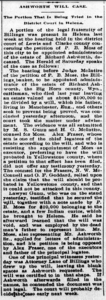
Billings Gazette, October 31, 1899.
In November, a second will was presented and the probate case continued for the term.
The litigation that was commenced in Helena October 26, seeking to have the estate of Richard Ashworth, the wealthy Wyoming cattleman, who died in May of this year near Marseilles, France, possessed of property in Montana, administered in Lewis and Clarke county, instead of this, took a sensational turn Saturday, when a second will was offered for probate in Helena….This will leaves all the dead man’s property to his father, Edward Ashworth of Manchester, England, with the exception of $5,000 life insurance, which is left to Jack Fraser of this city, the young man named in the other will as coming in for $75,000 of the estate.
The fight over the probate of the two wills, the one filed in Helena and the other in this city, is expected to be a legal battle royal. P.B. Moss of this [c]ity, acting for the father of the deceased, applied for letters of general administration of the estate, but Judge McIntire declined to grant the petition until the question of the wills had been settled, which must be decided by a jury.
The matter of the probating [of] the will in the county will be heard Friday by Judge Loud in this city.
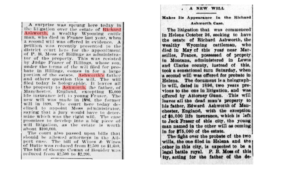
(left) Daily Intermountain, November 4, 1899. (right) Billings Gazette, November 7, 1899.
In December, Judge McIntire overruled Jack’s motion for dismissal. The case was going to litigation.

Billings Gazette, January 16, 1900.
In January 1900, litigation was avoided and the case settled: Jack Fraser withdrew his will and received $10,000. The earlier 1896 will presented by Edward Ashworth was approved over the 1898 will presented by Jack Fraser because the 1896 will was in Richard’s handwriting. The 1898 will was also suspect because there were blank names, executors, and beneficiaries when it was submitted to the court. It also helped that Edward had claims for money he had advanced to Richard that amounted to the same as the value of the estate. Later in January, Richard’s executor George Wise was in Omaha to sell Richard’s cattle and reported being “glad to hear that the contest over the probating of the two wills, purported to have been made by Mr. Ashworth, had been settled, thus avoiding a long suit.”
In March 1900, George Wise put a notice in the papers that all creditors to the Richard Ashworth estate were to present their bills and claims to George as the estate administrator. In June, George announced that he was selling on July 3rd in Wise, WY 14,500 sheep and 100 cow horses. In September, Judge McIntire of Helena authorized special administrator P.B. Moss to make expenditures settling claims, including one for J L Fraser. In October, George announced that he would be shipping several cars of cattle from Ballantine to Omaha aboard two special trains going east.
The ranch was put up for sale in 1901, and, in May of 1902, it sold to L. G. Phelps of Helena and Great Falls, Montana for $60,000. (Today, that purchase price would be $2,063,265.88). The purchase included “3,000 acres of patented land, the Ashworth cattle and horses” and the secured “leases to 11,000 acres of lands, from the state of Wyoming. The range controlled by the place is even larger, and although a long distance from a railroad the ranch is ideally located for stock raising.” The announcement reported that Richard had $7 in a Helena bank, his ranch, livestock, and a little more money in a Billings bank. After LG’s purchase, he posted a notice in the newspapers prohibiting shooting on the property. In 1903, Richard (well his estate) was still getting notices about being behind in taxes; property in Basin (land patent granted 1898) and Otto had amounted to over one hundred dollars (today, $3321.55). Another notice appeared in 1904 for Otto back taxes. In 1905, his property in Basin’s school district was listed for sale due to nonpayment of taxes.
Although not as well documented as other Meeteetse pioneers, Richard was an important part of the Meeteetse story. Thanks to newspapers and genealogy sites like Ancestry, we were able to piece together a history of Richard Ashworth and Wilfred Jevons. The only way we narrowed down the Ashworth tree in England was through newspapers mentioning Richard’s father Edward (although even one of those mentioned him as Richard senior) and brother Oliver. This story of a Meeteetse pioneer is by no means complete, but we hope you enjoyed tracing Richard Ashworth’s complicated history just as much as you have enjoyed the legend about the love triangle.
Complete set of references available at the Meeteetse Museum Archives.

